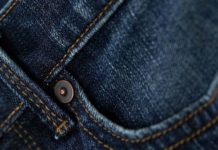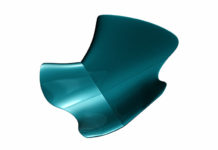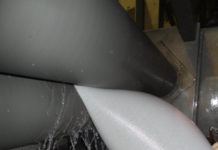Kappa 180 inkjet technology by Durst allows new creations, without any limit for design or colors, especially in the context of fabrics for domestic use. This is a high performance inkjet printer, of “piezo inkjet multipass” type, characterized by an advanced technology with Durst Quadro Z print heads and the availability of new Kappa inks. These are water-based and developed for printing on fabrics. They are totally eco-friendly inks such as Kappa R (reactive ink system) for cotton and mixed fabrics with over 60% cotton; Kappa D (dispersion ink system) for synthetics, polyester and mixed fabrics with over 50% polyester; Kappa A (acid ink system) for silk and silk mixed fabrics. Kappa R ink (reactive ink system) is GOTS certified. According to Greenpeace, Global Organic Textile Standard (GOTS) is the best quality brand for the entire textile production chain to satisfy criteria related to environment and toxicology. Compared to traditional printing methods, pre-printing processes can be omitted. Printing and any changes are done directly through the software. Water consumption can be reduced up to 90% and that of chemicals, too. Kappa 180 has fully automatic power drive and fabric guide, with195 cm max print width on adhesive base with integrated cleaning system. The dryer consists of a hot-air unit powered by steam or electricity. The novelties of Durst Quadro Array technology allow printing on textile supports through a particularly shock-resistant nozzle plan, with7/14/21 pico-litters drop size; 6144 jets are available for each color. A unique system of automatic cleaning of the nozzles ensures uninterrupted operation. Kappa 180 is an alternative to digital flatbed printing. This new technology is almost ready to be launched on the market having now been tested at some printing establishments in various parts of the world. So, printers will soon benefit from an efficient eco-friendly technology.
Clariant’s “One way” methodology
The production of denim fabrics represents approximately 14% of world cotton use. Its processing requires a large amount of water. Clariant has developed a system for the evaluation of the environmental impacts generated by the use of the various substances used for dyeing and refinement of this kind of fabrics. This special software is called “One Way” and is based on an evaluation approach of the so-called “four E” whose parameters affect processes: Ecology, Economy, Efficiency and Environment. Through its use, water consumption can be reduced by 92% compared with a traditional process. At the same time, normal cotton scraps can be reduced by 63% and energy costs by about 30%. All technical specifications of dyes and chemicals contained in One Way data system have been processed by Clariant specialists of Product Stewardship with reference to 15 eco-standard fabrics and various ecological standards, including bluesign®, OekoTex®, GOTS, the 11 groups of substances subject to restrictions, as set out in the roadmap of Zero Discharge of hazardous chemicals. At present over 200 substances have already been selected and integrated. In this way, software users can obtain specific appraisals for each article in progress with regard to toxicological and ecological standards. Clariant has calculated that the use of this software in the evaluation of work processes, only compared to 25% of denim products on a global scale, would result in 62 million m3 of water savings per year, the equivalent of the consumption by 1.7 million people. The system could also eliminate the need of treating 8.3 million m3 of waste water per year; saving 220 million kWh of electricity; greatly reduce the industry’s carbon footprint and CO2 emissions. Therefore, One Way would also allow manufacturers of jeans brands developing more eco- and economically sustainable innovative textile solutions.
“H2Color” dyes by Ecofoot
Ecofoot was founded in 2012 to develop and commercialize the exclusive H2Color dyes. The working group started at the textile research Centre of the University of Minho in Portugal.
Ecofoot is the first company that has made nano-dyes consisting of “ionic pigments”. In the textile industry, dyeing is carried out through water soluble dyes and affine with fibers. Pigments are generally used only in printing and are neither soluble nor affine. Dye particles are approximately 200 nm. They have some pigment properties, but they act mainly as a dye with affinity to specific fibers, as well as wet solidity comparable to dyes. Ultimately it is a composite of a particle of silica and a dye. New types of dyes result from them. Functional particles have affinity to natural fibers so they can be dyed evenly and with good coverage and quality penetration, for example, as in yarns. In mild tones they have good washing and rubbing resistance. Prints have even greater solidity with a single rinse and there is no need for fixing agents. Instead for dark tones a cationic fixing agent must be used. H2Color dyes are applied on natural fibers through exhaustion process. These dyes are “low salt” type in the sense that they don’t need salts or at least they need low salt amounts, showing however high exhaustion. Wool dyeing is carried out in acid environment, just like acid dyes and with the same temperatures. They can also be applied with pad-batch system as in the case of reactive dyes. As dyes do not hydrolyze, dye baths residues can be re-used. Currently, H2Color dyes are available for cotton, wool, and in “glow” type. The latter have fluorescent properties and are brighter than their equivalent standard color. A special method developed by Ecofoot allows converting any standard color in its equivalent fluorescent color. These dyes, due to their nature, allow saving energy, water and they reduce the need for purification of wastewater. They do not contain heavy metals in their molecules. For all these reasons they best satisfy the development of dyes for ecological processes and the preparation of final articles free from toxic substances.
by Antonio Mauro




